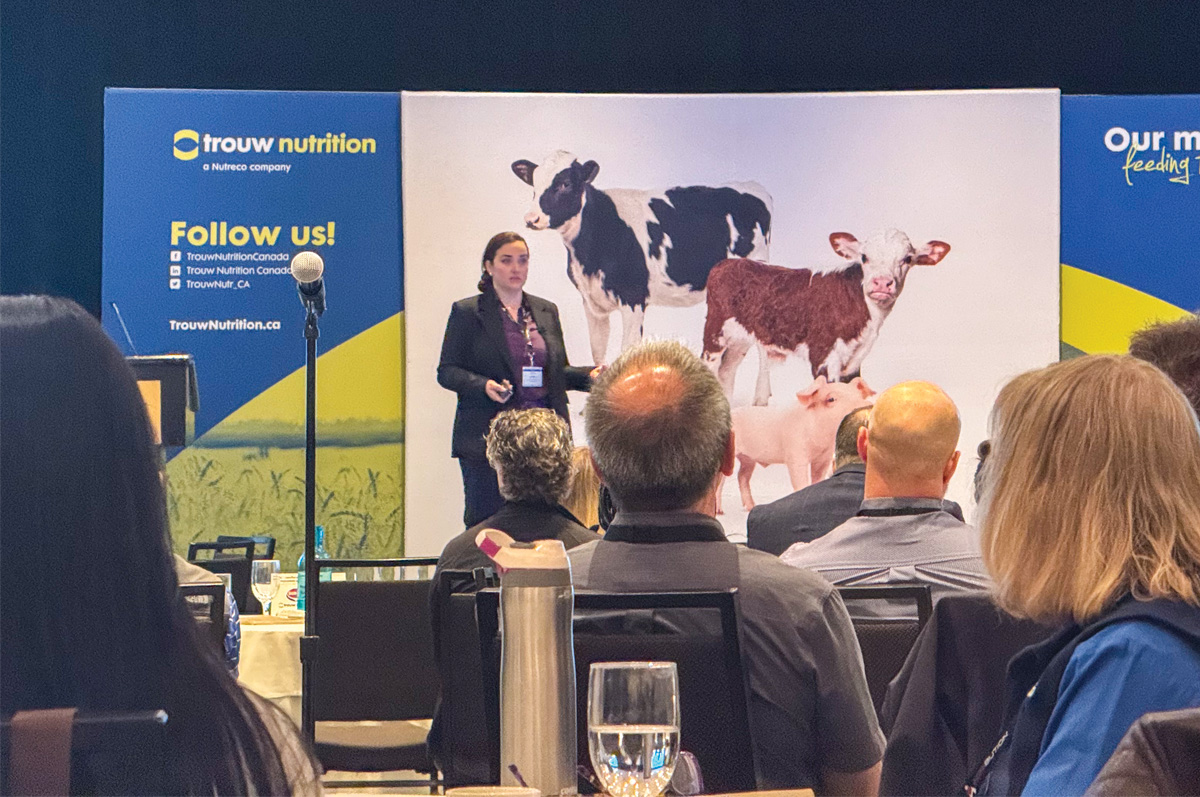On May 15 and 16, a global crowd of specialists in livestock feed and nutrition gathered at the Fairmont Winnipeg for the annual Animal Nutrition Conference of Canada (ANCC) to confer on this year’s conference theme: “Animal nutrition and feed security: Global changes and local approaches.” In accordance with the theme, conference speakers shared diverse perspectives on some of the most pressing issues facing the livestock feed industry, ranging from the emergence of lab-grown proteins to the quest for net zero, and the role of trace mineral additives in sustainability.
The first day of the conference, presentations were divided into a preconference symposium sponsored by Trouw Nutrition, with the theme “Nourishing the future with sustainable nutrition,” followed by the afternoon’s opening plenary organized by the Animal Nutrition Association of Canada. Here are some of the key takeaways on a selection of topics from this first day of presentations.
Charting the path to net zero
Kicking off the event’s presentations was Ermias Kebreab, associate dean at the University of California – Davis. Kebreab outlined strategies for achieving net-zero emissions in livestock production, choosing to distinguish solutions according to their impact on direct or indirect emissions from the livestock sector, noting the sector’s supply side has the potential to reduce up to 70% of its emissions.
Direct emission sources include things like enteric methane, manure management, applications of manure on pasture and soil fertilizer applications. Opportunities for improving indirect emissions are available through approaches like improving crop yields through no-till farming and improving yields in low-income countries. The latter was a key example highlighted by Kebreab, who reported 71% of livestock emissions come from dairy production systems producing less than 1,000 kilograms of milk per cow per year, making this an important area for improvement.
Kebreab’s top three strategies to achieve net zero were:
- Feed additives for reducing enteric methane emissions
- Improving breeding to increase livestock productivity
- Improving productivity, particularly in low-income countries
Sustainable dairy theory in practice
“We want to make sure the way we talk about methane and cows is different from the ways we talk about methane from other sources,” said Carlyn Peterson, dairy technical manager with Selko USA. Peterson’s presentation encouraged industry professionals to take stock of their accomplishments and understand amid the pressures and goals to reduce methane emissions, ruminants participate in the biogenic carbon cycle, which sees cattle as active participants in plants’ abilities to sequester carbon – a critical role not achieved by industrial methane sources.
With that in mind, Peterson emphasized the need for small tweaks to make a cumulative difference and realize continuous improvement. Highlighting methane reduction strategies like diet reformulation, selecting for low-methane animals in breeding and using manure additives, she reminded attendees to think about the return on investment for producers and the importance of factoring farm profits into climate conversations. For this reason, she advocated for increasing the productive efficiency of dairies through management strategies like heat mitigation and increasing lying time.

Dr. Carlyn Peterson shared her insights into dairy sustainability in North America during her presentation “Dairy sustainability: Translating theory to practice.” Photo by Emma Ohirko.
The influence of trace mineral additives on livestock sustainability
Gavin Boerboom, global program manager for trace minerals at Selko, explored the delicate balance between trace mineral supplementation for nutritional requirements and minimizing environmental impact. This objective is key because excessive supplementation can lead to environmental contamination.
He noted that trace minerals are typically overfed and argued nutritionists should focus on selecting the right source and form of trace minerals to optimize bioavailability and minimize waste. “What [nutritionists are] realistically trying to do is increase the probability that we will be in homeostatic performance,” Boerboom explained.
Animal protein and its substitutes: Perspectives and issues
Rounding out the day’s proceedings was Maurice Doyon, professor at the University of Laval’s department of agri-food economics and consumer science. Doyon discussed the multifaceted landscape of protein selection and trends in consumption. He noted a shift in Organisation for Economic Co-operation and Development (OECD) countries toward lower carbon-intensive meats like chicken and pork, as well as toward plant-based proteins. While total meat consumption has increased in Canada, per capita consumption has declined.
The "battle of proteins" aptly describes the competition among traditional animal proteins, lab-grown alternatives and nonanimal protein meals, Doyon argued.
Sustainability is a central concern, but the primary drivers of plant-based food consumption are not philosophical, making them more sensitive to price changes. Meanwhile, lab-grown animal protein and molecular agriculture, which involves gene-editing animal proteins into plants, are emerging but remain energy-intensive and costly. Livestock producers and processors continue to add value to their products to stay competitive as these protein alternatives find their place in the market, he concluded.
ANCC 2025
Next year’s ANCC will be held on May 7-9 in Niagara Falls, Ontario.










